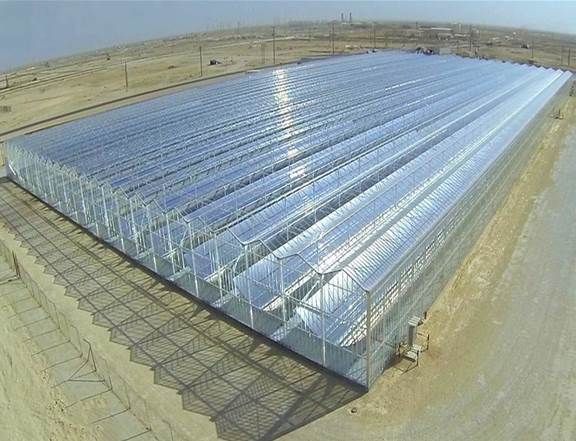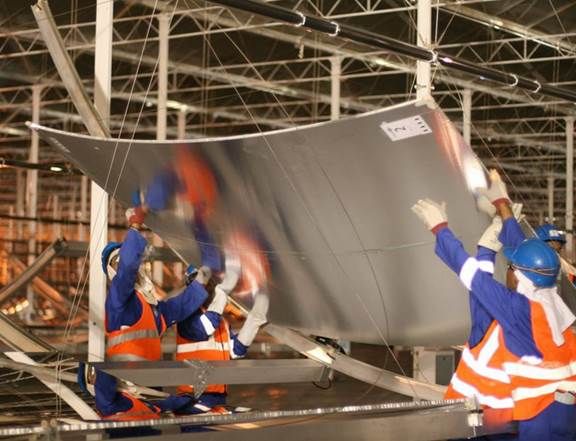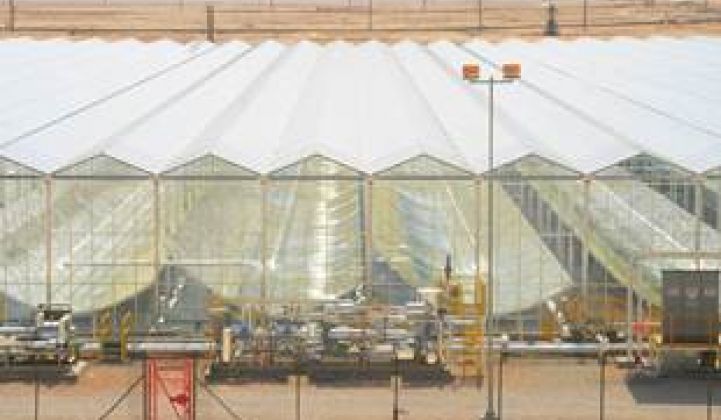GlassPoint Solar is a step closer to proving that its enclosed trough concentrating solar technology is effective at enhancing oil recovery.
GlassPoint is now producing 50 tons of steam per day at its 7 megawatt project in the southern interior region of Oman, according to Business Development VP John O’Donnell. That translates to 110 million British Thermal Units (BTUs) of energy per day and replaces about 1 percent of the natural gas-fired steam used for enhanced oil recovery (EOR) at the Amal oil field.
The project, O’Donnell added, came in on budget and on time, despite its “severely remote” location and the "hardest" of desert conditions.
"Played-out" oil wells hold a third or more of their potential in heavy oil that is not recoverable via conventional drilling and pumping methods. For decades, natural gas has been used to boil water into pressurized steam that, flooded into the well, can turn the oil more fluid so that pumping can keep it coming up.
Concentrating solar installations in California by ARCO Solar, BrightSource Energy, Areva, and GlassPoint proved the technical feasibility of using concentrating solar power (CSP) to produce steam for EOR, but have not yet shown it to be cost-effective.
GlassPoint recently won $26 million in Round B financing from oil giant Royal Dutch Shell (NYSE:RDS.A), as well as RockPort Capital, Nth Power, and Chrysalix Energy Venture Capital, to continue development of its enclosed trough CSP concept.

Solar power tower technology is capable of bringing operating fluids to the higher temperatures needed to make thermal storage possible, and it seems to be siphoning favor away from the older and more proven parabolic trough technology used by GlassPoint.
But the very efficiencies that make power tower technology able to achieve the higher temperatures, GlassPoint CEO Rod MacGregor told GTM, are why trough technology is better suited for EOR. Both a Ferrari and a Ford F150 pickup can pull a trailer, he said, but it is not economic to use the Ferrari.
“If its technology works, the company could benefit from a first-mover advantage into a niche market that could prove to be sizable and attractive,” GTM Research Solar Market Analyst Scott Burger noted.
But with the newfound abundance and consequent low price of natural gas, “the world has turned upside down,” O’Donnell said. To compete in California oil fields, which produce half of the state’s consumed oil, and with half of that from natural gas-driven EOR, solar EOR would have to come in at $3 to $5 per million BTUs.
In the Middle East, however, GlassPoint’s technology gives it several advantages, O’Donnell explained.
The air there is twelve times dirtier than in the U.S. Southwest, making CSP operations and maintenance (O&M) key to productivity, O’Donnell said. Tower technologies’ heliostats have to be cleaned frequently, consuming a great deal of water and labor.
GlassPoint’s aluminum parabolic trough mirrors on single-axis trackers are enclosed in agricultural glass greenhouses that are cleaned robotically, using a process that allows for 90 percent water recovery. And because they have been in use for decades, there is no need to scale-up a supply chain.
GlassPoint’s technology is also designed, MacGregor said, to handle the dirty feed water and harsh low maintenance conditions of an oil field. And GlassPoint’s facilities require less capital and less land because they do not have to achieve the high temperatures required by tower technologies. What's more, the devices are built with materials that do not have to stand up to the harsh desert environment, because they are protected by the glass enclosure.

As evidence that GlassPoint’s technology is cost-competitive in Middle East oil fields, O’Donnell pointed out that Petroleum Development Oman, the project owner, had selected it over competitors in an open bidding process.
“The keys to bringing costs down are speed, certainty and scale,” O’Donnell said. “This little unit is a pilot for larger installations. Those are targeted at the $3 per million BTUs to $5 per million BTUs price of gas in that region, and that is what the technology is developed to deliver.” O’Donnell declined to discuss whether GlassPoint has won future commitments.
Unlike the U.S., where shale reserves and fracking technologies have produced a plentiful natural gas supply, Middle East gas is rapidly being consumed by domestic and EOR needs, O’Donnell explained.
“Other major oil-producing nations in the MENA region, including the UAE, Kuwait, and Saudi Arabia, will continue to face natural gas shortages,” Burger affirmed.
One recent study predicted the global EOR market will be $16.3 billion in 2014. Over 40 percent of California’s century-old oil wells now require enhancement, and that is expected to rise to 60 percent in the next few years.
The real market, MacGregor said, is the Middle East, where a “perfect EOR storm” favoring solar is setting in. Light crude in many Middle East fields is largely played out, he explained, and there is a shortage of natural gas, as well as plenty of sun.




